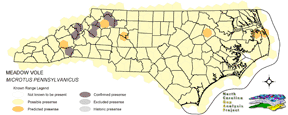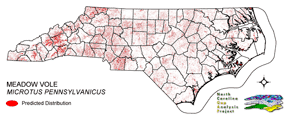
| Taxa: |
| Order: |
| Family: |
| Mammalia |
| Rodentia |
| Muridae |
| NatureServe Global Rank: |
| NatureServe State (NC) Rank: |
| G5 |
| S5 |
| Federal Status: |
| NC State Status: |
| --- |
| --- |


| Land Unit |
| US Fish & Wildlife Service |
| US Forest Service |
| US National Park Service |
| US Department of Defense |
| NC State Parks |
| NC University System |
| NC Wildlife Res. Com. |
| NC Forest Service |
| NC Div. of Coastal Mgmt. |
| Local Governments |
| Non-Governmental Org. |
| Other Public Lands |
| Private Lands |
| GAP Status 1-2 |
| All Protected Lands |
| Statewide |
| Hectares |
| 21,396.24 |
| 11,738.88 |
| 15,318.63 |
| 11,650.05 |
| 2,201.13 |
| 299.79 |
| 6,132.87 |
| 449.97 |
| 1,485.54 |
| 337.05 |
| 2,483.82 |
| 553.59 |
| 1,390,765.59 |
| 40,375.86 |
| 72,736.08 |
| 1,464,813.15 |
| Acres |
| 52,871.25 |
| 29,007.40 |
| 37,853.15 |
| 28,787.89 |
| 5,439.11 |
| 740.80 |
| 15,154.65 |
| 1,375.96 |
| 3,670.85 |
| 832.87 |
| 6,137.65 |
| 1,367.95 |
| 3,436,655.95 |
| 100,034.96 |
| 179,998.79 |
| 3,619,895.47 |
| % of Dist. on |
| Prot. Lands |
| 29.4 % |
| 16.1 % |
| 19.9 % |
| 16.0 % |
| 3.0 % |
| 0.4 % |
| 8.2 % |
| 0.6 % |
| 2.0 % |
| 3.4 % |
| 3.4 % |
| 0.4 % |
| < 0.1 % |
| 55.5 % |
| ----- |
| ----- |
| % of Dist. on |
| All Lands |
| 1.5 % |
| 0.8 % |
| 1.0 % |
| 0.8 % |
| 0.2 % |
| < 0.1 % |
| 0.4 % |
| < 0.1 % |
| 0.1 % |
| < 0.1 % |
| 0.2 % |
| < 0.1 % |
| 94.9 % |
| 2.8 % |
| ----- |
| ----- |
|
This species is associated with tall grass, sedge and forb habitats of all kinds and at all elevations within its range (Whitaker and Hamilton 1998). It inhabits everything from tidal marshes along the Carolina coast to alpine meadows above treeline in the northern Appalachian and Adirondack mountains of New England. However, it becomes less abundant at the
southern limits of its range in North Carolina, South Carolina and Georgia. Within North Carolina, it is locally common in the piedmont and mountains, uncommon to rare in the northern coastal plain and Outer Banks, and absent from the southern coastal plain (Lee et al. 1982, Webster et al. 1985). Best associated with moist, densely vegetated fields of grasses and sedges (Whitaker and Hamilton 1998). It is less adapted to short-grass communities or actively managed fields that are maintained at short-grass levels. High-grass lowland and upland meadows and fields, pastures with areas of tall dense grasses and forbs, fresh and salt water marshes, and to a lesser extent open glades in woodlands are all used by this vole. Dense grassy areas in open woods, orchards and along roadsides are also well suited to the meadow vole. Meadow voles build above ground nest of grass and other available herbaceous vegetation and require tall, dense herbaceous cover to adequately conceal these structures (Whitaker and Hamilton 1998). NATURE SERVE GLOBAL HABITAT COMMENTS: Found in a wide variety of habitats from dry pastures and wooded swamps to marshes and orchards. Needs loose organic soils for tunneling. Builds extensive underground tunnels. Nests in these tunnels under rocks or logs, and in self-constructed grassy clumps. |
| Code | Name | Description | NC Natural Heritage Program Equivalent |
| 3 | Tidal Marsh | Fresh and brackish tidal marshes, including cord grass, wild rice, sawgrass and needlerush alliances. | Brackish Marsh, Interdune pond, Maritime wet grassland |
| 372 | Interdune Herbaceous Wetlands | Dune swales with permanently flooded to intermittently exposed hydrology. Species composition depends on salinity and can include cut grass, spike-rush, mosquito fern, and hornwort. | Interdune Pond, Maritime Wet Grasslands |
| 371 | Maritime Grasslands | Dune grass community consisting of sea oats and beach grasses. | Dune grass, Maritime dry grassland |
| 380 | Coastal Plain Fresh Water Emergent | Emergent vegetation in fresh water seepage bogs, ponds and riverbeds of the coastal plain. Includes alliances dominated by sedges, eelgrass, as well as cane found in unforested cane-brakes. | Small Depression Pond, Sandhill Seep, Floodplain Pool, Unforested Floodplain Canebrake, Riverscour Prairies, Vernal Pools |
| 239 | Piedmont/Mountain Emergent Vegetation | Emergent vegetation of all wetland hydrologies. Sites would commonly support species such as tussock sedge, rushs, and cattail alliances. | Rocky Bar and Shore (in part) |
| 205 | Agricultural Pasture/Hay and Natural Herbaceous | Farm fields used for pasture grass or hay production, as well as old fields dominated by native and exotic grasses. | No equivalent |
| 202 | Residential Urban | Includes vegetation interspersed in residential areas. Includes lawns, mixed species woodlots, and horticultural shrubs. Vegetation accounts for between 20 - 70% of the cover. | No equivalent |
| 523 | Grassy Bald | High Elevation grassy balds including Pennsylvania sedge, mountain oatgrass, as well as shrubby areas dominated by Alleghany and smooth blackberry. | Grassy Bald |
|
Krebs, C.J. and J.H. Myers. 1974. Population cycles in small mammals. Adv. Ecol. Res. 8:267-399.
Reich, L.M. 1981. Microtus pennsylvanicus. Am. Soc. Mamm., Mammalian Species No. 159. 8pp. Moyer, C. A., G. H. Adler, and R. H. Tamarin. 1988. Systematics of New England MICROTUS, with emphasis on MICROTUS BREWERI. J. Mammalogy 69:782-794. Swihart, R. K. 1990. Quebracho, thiram, and methiocarb reduce consumption of apple twigs by meadow voles. Wildl. Soc. Bull. 18:162-166. Frey, J. K. 1992. Response of a mammalian faunal element to climatic changes. J. Mamm. 73:43-50. Ostfeld, R. S., and C. D. Canham. 1993. Effects of meadow vole population density on tree seedling survival in old fields. Ecology 74:1792-1801. Allen, G.M. 1942. Extinct and vanishing mammals of the Western Hemisphere. Am. Comm. Int. Wild. Prot., Spec. Prob. No. ll. 620 pp. Jones, J. K., Jr., et al. 1992. Revised checklist of North American mammals north of Mexico, 1991. Occas. Pap. Mus., Texas Tech Univ. (146):1-23. Tobin, M. E., and M. E. Richmond. 1993. Vole management in fruit orchards. U.S. Fish and Wildlife Service Biological Report 5. ii + 18 pp. Wilson, D. E., and D. M. Reeder (editors). 1993. Mammal Species of the World:a Taxonomic and Geographic Reference. Second Edition. Smithsonian Institution Press, Washington, DC. xviii + 1206 pp. Sullivan, T. P., and D. S. Sullivan. 1988. Influence of alternative foods on vole populations and damge in apple orchards. Wildl. Soc. Bull. 16:170-175. Whitaker, J.O. Jr. and W.J. Hamilton, Jr. 1998. Mammals of the eastern United States. Cornell Univ. Press, Ithaca, New York. 583 pp. Chamberlain, J.L. 1954. THE BLOCK ISLAND MEADOW MOUSE, MICROTUS PROVECTUS. J. MAMMAL. 35:587-589. Plante, Y., P. T. Boag, and B. N. White. 1989. Macrogeographic variation in mitochondrial DNA of meadow voles (MICROTUS PENNSYLVANICUS). Can. J. Zool. 67:158-167. Clark, B. K., and D. W. Kaufman. 1990. Short-term responses of small mammals to experimental fire in tallgrass prairie. Can. J. Zool. 68:2450-2454. Lee, D. S., L. B. Funderburg Jr., and M. K. Clark. 1982. A distributional survey of North Carolina mammals. Occasional Papers of the North Carolina Biological Survey, No. 1982-10. North Carolina State. Mus. Nat. Hist., Raleigh, North Carolina. 72 pp. Moore, D. W., and L. L. Janecek. 1990. Genic relationships among North American MICROTUS (Mammalia:Rodentia). Ann. Carnegie Mus. 59:249-259. Conner, P. F. 1971. The mammals of Long Island, New York. New York. State Mus. Science Serv., Bull. No. 416. 78 pp. Banfield, A.W.F. 1974. The mammals of Canada. University of Toronto Press, Toronto. Godin, A.J. 1977. Wild Mammals of New England. Johns Hopkins University Press, Baltimore. 304 pp. Hamilton, William J., Jr., and John O. Whitaker, Jr. 1979. Mammals of the eastern United States. Cornell Univ. Press, Ithaca, New York. 346 pp. Hall, E. R. 1981. The Mammals of North America. Second edition. 2 Volumes. John Wiley and Sons, New York, New York. Schwartz, Charles W., and Elizabeth R. Schwartz. 1981. The wild mammals of Missouri. University of Missouri Press, Columbia. 356 pp. Baker, Rollin H. 1983. Michigan mammals. Michigan State University Press. 642 pp. Modi, W. S. 1986. Karyotypic differentiation among two sibling species pairs of New World microtine rodents. J. Mammalogy 67:159-165. Tamarin, R. H., editor. 1985. Biology of New World MICROTUS. American Soc. Mamm. Special Publication (8):1-893. Webster, W. D., J. F. Parnell and W. C. Biggs Jr. 1985. Mammals of the Carolinas, Virginia, and Maryland. The University of North Carolina Press, Chapel Hill, NC. Ambrose, H.W. 1973. An experimental study of some factors affecting the spatial and temporal activity of Microtis pennsylvanicus. J. Mamm. 54:79-110. |
For more information please contact them at:
NC-GAP Analysis Project
Dept. of Zoology, NCSU
Campus Box 7617
Raleigh, NC 27695-7617
(919) 513-2853
www.basic.ncsu.edu/ncgap